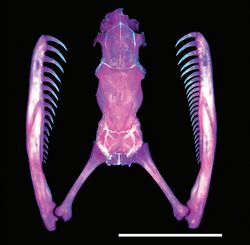Biology:Iwasaki's snail-eater
| Iwasaki's snail-eater | |
|---|---|

| |
| Scientific classification | |
| Domain: | Eukaryota |
| Kingdom: | Animalia |
| Phylum: | Chordata |
| Class: | Reptilia |
| Order: | Squamata |
| Suborder: | Serpentes |
| Family: | Pareidae |
| Genus: | Pareas |
| Species: | P. iwasakii
|
| Binomial name | |
| Pareas iwasakii (Maki, 1937)
| |
| Synonyms | |
| |
Iwasaki's snail-eater (Pareas iwasakii) is a species of snake in the family Pareidae. The species is endemic to the Yaeyama Islands in the southern Ryukyu Islands, Japan .[2]
Etymology
The specific name, iwasakii, is in honor of Japanese meteorologist Takuji Iwasaki.[3]
Ecology
Pareas iwasakii is a snail-eating specialist;[4] even newly hatched individuals feed on snails.[5] It has asymmetric jaws, with more teeth on the right (about 25 teeth compared to 15 teeth on the left) which facilitates feeding on snails with dextral (clockwise coiled) shells.[6] A consequence of this asymmetry is that Pareas iwasakii is much less adept at preying on sinistral (counterclockwise coiled) snails.[7] It systematically directs its attack on snails from the right in order to insert its lower jaw into the shell opening.
The selection pressure of this predator on snails of the genus Satsuma (en) has led to a significant increase in the proportion of snails with left-facing shells, known as levogyres, compared to snails with right-facing shells, known as dextrogyres, because the two forms have difficulty mating with each other. This proportion is a local originality, the levorotatory form being very rare on a worldwide scale.[7]
Taxonomy
Originally described as Amblycephalus formosensis iwasakii by Moichirō Maki,[8] it is currently placed in the genus Pareas.[9]
References
- ↑ Kidera, N.; Ota, H. (2017). "Pareas iwasakii". IUCN Red List of Threatened Species 2017: e.T16220A96877422. doi:10.2305/IUCN.UK.2017-3.RLTS.T16220A96877422.en. https://www.iucnredlist.org/species/16220/96877422. Retrieved 16 November 2021.
- ↑ 2.0 2.1 Pareas iwasakii at the Reptarium.cz Reptile Database
- ↑ Beolens B, Watkins M, Grayson M. (2011). The Eponym Dictionary of Reptiles. Baltimore: Johns Hopkins University Press. xiii + 296 pp. ISBN:978-1-4214-0135-5. (Pareas iwasakii, p. 131).
- ↑ Hoso, M.; M. Hori (2006). "Identification of molluscan prey from feces of Iwasaki's slug snake, Pareas iwasakii". Herpetological Review 37: 174–176.
- ↑ Hoso, M. (2007). "Oviposition and hatchling diet of a snail-eating snake Pareas iwasakii (Colubridae: Pareatinae)". Current Herpetology 26: 41–43. doi:10.3105/1345-5834(2007)26[41:OAHDOA2.0.CO;2].
- ↑ Hoso, Masaki; Takahiro Asami; Michio Hori (2007). "Right-handed snakes: convergent evolution of asymmetry for functional specialization". Biology Letters 3 (2): 169–173. doi:10.1098/rsbl.2006.0600. PMID 17307721.
- ↑ 7.0 7.1 Hoso, Masaki; Yuichi Kameda; Shu-Ping Wu; Takahiro Asami; Makoto Kato; Michio Hori (2010). "A speciation gene for left-right reversal in snails results in anti-predator adaptation". Nature Communications 1 (9): 133. doi:10.1038/ncomms1133. PMID 21139578.
- ↑ Maki, M (1937). "A new subspecies, Amblycephalus formosensis iwasakii, belonging to Amblycephalidae Ishigaki-jima". Trans. Nat. Hist. Soc. Formosa 27: 217–218.
- ↑ Ota, Hidetoshi; Jun-Tsong Lin; Toru Hirata; Szu-Lung Chen (1997). "Systematic review of colubrid snakes of the genus Pareas in the East Asian islands". Journal of Herpetology 31 (1): 79–87. doi:10.2307/1565332.
Further reading
- Hoso, Masaki; Hori, Michio (2008). "Divergent Shell Shape as an Antipredator Adaptation in Tropical Land Snails". American Naturalist 172 (5): 726–32. doi:10.1086/591681. PMID 18834301..
Wikidata ☰ Q2704387 entry
 |




